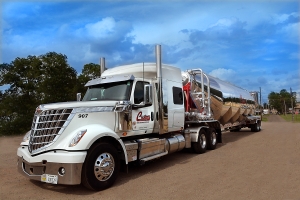
If the ongoing shortage of truck drivers has made one thing clear, it’s that recruiting and retaining drivers is more important than ever. Hiring, training, and retaining dedicated drivers is crucial to finding success in today’s economy, and it all starts with the recruitment of the right candidates for the job.
Struggling to attract talent or recruit them into your organization? Wondering how to meet the demands of the market and stay competitive in an ever-changing industry? These 4 tips are sure to help you set your organization up for success when recruiting truck drivers.
-
Make Your Marketing Driver-Centric
In today’s world, drivers look to the regular marketing channels to find information about prospective companies and fleets. This means that good recruitment strategies begin with strong marketing and carefully curated content.
What kinds of content currently exist on the company website and social media pages? Information about how successful a company is won’t be of much interest to a potential employee. It’s important to highlight driver-centric content, or the kinds of benefits a driver can receive from your company.
Ultimately, a driver wants to know that the company will treat their drivers with care and provide the benefits they are looking for.
Highlight any wellness programs or culture initiatives that differentiate your company from the competition. Providing information on schedules, work-life balance, and fleet amenities can help drivers see how much you care. Including testimonials from current, satisfied employees builds trust and offers the real insight drivers are looking for.
Remember, drivers are always wondering “what can they do for me?” Driver-centric marketing will leave no doubt in their mind that you’re the right company for them.
-
Target the Right Audience
Before you start moving prospective drivers through the recruitment pipeline, you have to be sure you’re selecting from the best pool of candidates for the job.
Many driving fleets have very specific needs and requirements that not all candidates are ideal for. Knowing how to target the right segment of candidates will make the process more efficient and effective.
Databases allow you to select drivers based on driver type, years of experience, haul experience, geographical location, and other factors. Focusing on any of these segments early in the recruiting process can save you time and energy. It will also increase the overall effectiveness of the company. By not optimizing this stage of recruitment, you could potentially lose hours chasing leads which were never well suited for that particular fleet or job.
If you don’t have an easy or effective way to browse data on prospective drivers, Drive My Way can help you target the specific segment of drivers needed for your particular situation.
-
Use the Latest Digital Recruiting Methods
Driver recruitment methods are constantly changing, so it’s important to stay up to date with the latest and most effective strategies. Social media continues to evolve as a tool, and drivers use these platforms to research companies, read comments, and evaluate employers. Since drivers are often on the road, they’ll use their mobile devices to search for job leads.
When viewers like, follow, share, or comment on your content, it can increase the audience exponentially. But advertising job postings on social media channels isn’t enough to attract the talent you’re looking for.
Post engaging content on your platforms which drivers will want to view. In addition, search engine optimization of your content will ensure that your website is receiving as much traffic as possible. Use software like Google Analytics and Google Keyword Planner to optimize your post by including trending phrases and words.
Applications should be short and mobile-friendly to avoid any bottlenecking in the recruiting process. Drivers often don’t have enough time to fill out a long application, so a shorter version with only basic information required is best initially, with the option to complete the remaining components later.
It’s helpful to stay on top of the latest digital tools for recruiting and analyze which strategies could be useful for your company.
-
Re-engage Old Leads
In the trucking industry, the unusually high turnover rate of drivers poses a unique challenge for recruiters.
One of the best ways a recruiter can continually bring people into the pipeline is by re-engaging old leads or cold leads.
Many drivers who could be a perfect fit but were previously unavailable or chose to drive for a different fleet might be available and looking for opportunities again. Leads and prospects that have gone cold or did not convert into driver status should not be forgotten. Instead, keep them in mind for the future and maintain a connection.
Drip marketing, engaging content on blogs, social media, and newsletters are all great strategies to stay connected to old leads and assure that your fleet remains fresh on their minds when they’re considering a new employer.
While driver recruiting in the trucking industry can be daunting, many of the unique challenges you face can be combated by these solutions. Master these four tips to experience recruiting as it should be: easy, effective, and rewarding.

 On average, team drivers are more experienced drivers and seasoned negotiators than most solo drivers, so recruiting them to your organization may take a bit more than what you’re used to as a recruiter. If you’re a recruiter who’s recently been tasked with hiring team drivers, here are 4 tips that can help you along the way.
On average, team drivers are more experienced drivers and seasoned negotiators than most solo drivers, so recruiting them to your organization may take a bit more than what you’re used to as a recruiter. If you’re a recruiter who’s recently been tasked with hiring team drivers, here are 4 tips that can help you along the way.  Team drivers on average make more than their solo counterparts. If your carrier is serious about hiring qualified team drivers, you’ll most likely have to up their pay from what you’d give a solo driver.
Team drivers on average make more than their solo counterparts. If your carrier is serious about hiring qualified team drivers, you’ll most likely have to up their pay from what you’d give a solo driver.  Many established team drivers are couples. This makes sense, since if you had to choose to live in a confined space with anyone for days, maybe weeks at a time, it would probably be your significant other.
Many established team drivers are couples. This makes sense, since if you had to choose to live in a confined space with anyone for days, maybe weeks at a time, it would probably be your significant other. 
 We talked to CDL Driver, Angela who hauls with her husband Larry and she told us that the thing he likes the least about team driving is not being able to get a good night’s sleep while the truck is moving. This is a common complaint for a lot of team drivers. In fact, it’s not just issues sleeping, it’s an issue of comfort overall.
We talked to CDL Driver, Angela who hauls with her husband Larry and she told us that the thing he likes the least about team driving is not being able to get a good night’s sleep while the truck is moving. This is a common complaint for a lot of team drivers. In fact, it’s not just issues sleeping, it’s an issue of comfort overall.  We’ve talked before about the power of driver testimonials in the trucking industry. While they’re great for recruiting solo drivers, they’re even better for hiring team drivers.
We’ve talked before about the power of driver testimonials in the trucking industry. While they’re great for recruiting solo drivers, they’re even better for hiring team drivers.  Comprehensive CDL Recruitment Solutions
Comprehensive CDL Recruitment Solutions


 Slowly but surely, companies are re-opening and finding a new normal. The widespread shutdowns due to COVID-19 will continue to ease, but the effects of the pandemic are likely to linger for far longer. With millions of Americans becoming remote workers overnight, virtual recruiting and onboarding have become the norm for many companies. Even as restrictions on in-person work environments are relaxed, prepare to manage your
Slowly but surely, companies are re-opening and finding a new normal. The widespread shutdowns due to COVID-19 will continue to ease, but the effects of the pandemic are likely to linger for far longer. With millions of Americans becoming remote workers overnight, virtual recruiting and onboarding have become the norm for many companies. Even as restrictions on in-person work environments are relaxed, prepare to manage your 


 1. Hiring Drivers
1. Hiring Drivers
 Just as you are sacrificing time to attend these events, so are drivers. It’s fair to say, most drivers have reduced availability to attend events like these, as they are often on the road with limited hours.
Just as you are sacrificing time to attend these events, so are drivers. It’s fair to say, most drivers have reduced availability to attend events like these, as they are often on the road with limited hours. Megan Andrews is a Customer Success Manager at Drive My Way. She worked for a National Recruiting Agency prior to joining the Drive My Way Team in early 2021. During her time with her previous employer, she worked with small mom and pop companies up to Fortune 500 companies to find the best talent across all industries.
Megan Andrews is a Customer Success Manager at Drive My Way. She worked for a National Recruiting Agency prior to joining the Drive My Way Team in early 2021. During her time with her previous employer, she worked with small mom and pop companies up to Fortune 500 companies to find the best talent across all industries. 
 The most important part of strong communication with drivers is good listening. This means you actually take time and effort to hear drivers’ concerns and then address them. Good listening isn’t just reactive. Don’t just wait for drivers to come to you with their concerns. Be curious enough to inquire about their needs and questions.
The most important part of strong communication with drivers is good listening. This means you actually take time and effort to hear drivers’ concerns and then address them. Good listening isn’t just reactive. Don’t just wait for drivers to come to you with their concerns. Be curious enough to inquire about their needs and questions.




 The concern that female truck drivers have over equipment is two-fold. First, consider the ergonomics of a standard semi-truck cab. Generally, they’re built to fit the physical size of a larger man. It can be difficult for some women to reach the controls or get the seats adjusted into a comfortable position while keeping their feet on the pedals.
The concern that female truck drivers have over equipment is two-fold. First, consider the ergonomics of a standard semi-truck cab. Generally, they’re built to fit the physical size of a larger man. It can be difficult for some women to reach the controls or get the seats adjusted into a comfortable position while keeping their feet on the pedals.  The issue of safety is one that female truck drivers of all ages and backgrounds are aware of. Safety from physical harm or the threat of sexual violence is important for all women but affects female truck drivers in unique ways.
The issue of safety is one that female truck drivers of all ages and backgrounds are aware of. Safety from physical harm or the threat of sexual violence is important for all women but affects female truck drivers in unique ways. 





 Now more than ever, the ability for carriers to retain truck drivers is key. As the labor market
Now more than ever, the ability for carriers to retain truck drivers is key. As the labor market The last thing a driver wants is a carrier that over-promises and under-delivers. Before posting a job, carriers should take the time to l
The last thing a driver wants is a carrier that over-promises and under-delivers. Before posting a job, carriers should take the time to l Sometimes it takes a carrier posting a job advertisement on Facebook for them to find out that their current drivers are unsatisfied. Maybe their pay is too low, their benefits aren’t desirable, or the carrier over-promises and under-delivers.
Sometimes it takes a carrier posting a job advertisement on Facebook for them to find out that their current drivers are unsatisfied. Maybe their pay is too low, their benefits aren’t desirable, or the carrier over-promises and under-delivers.  Instead of constantly investing in lofty sign-on bonuses to attract new drivers, carriers should implement referral bonus programs and
Instead of constantly investing in lofty sign-on bonuses to attract new drivers, carriers should implement referral bonus programs and  In the trucking industry, we hear a lot about a shortage of truck drivers and how that’s to blame for a lot of the logistics holdups our country is facing. While hiring and retaining truck drivers is definitely an issue that a lot of carriers are facing, there’s another that’s proving to be just as much of an obstacle; a shortage of semi-trucks.
In the trucking industry, we hear a lot about a shortage of truck drivers and how that’s to blame for a lot of the logistics holdups our country is facing. While hiring and retaining truck drivers is definitely an issue that a lot of carriers are facing, there’s another that’s proving to be just as much of an obstacle; a shortage of semi-trucks.  If you’ve tried to buy a personal car, pick-up truck, or SUV in the past two years, you’re probably aware of the microchip shortage that the auto industry is facing. Unfortunately for fleet managers and would-be owner operators, this is an issue for the trucking industry as well.
If you’ve tried to buy a personal car, pick-up truck, or SUV in the past two years, you’re probably aware of the microchip shortage that the auto industry is facing. Unfortunately for fleet managers and would-be owner operators, this is an issue for the trucking industry as well.  The two main groups being affected by the semi-truck shortage are fleet managers and owner operators. Owner operators eager to either buy their first truck or upgrade to a new one are finding it hard to do so with limited inventory and skyrocketing prices for both new and used trucks. Many dealers across the U.S
The two main groups being affected by the semi-truck shortage are fleet managers and owner operators. Owner operators eager to either buy their first truck or upgrade to a new one are finding it hard to do so with limited inventory and skyrocketing prices for both new and used trucks. Many dealers across the U.S 


 Custom Commodities Transport Partners with Drive My Way for Success
Custom Commodities Transport Partners with Drive My Way for Success

